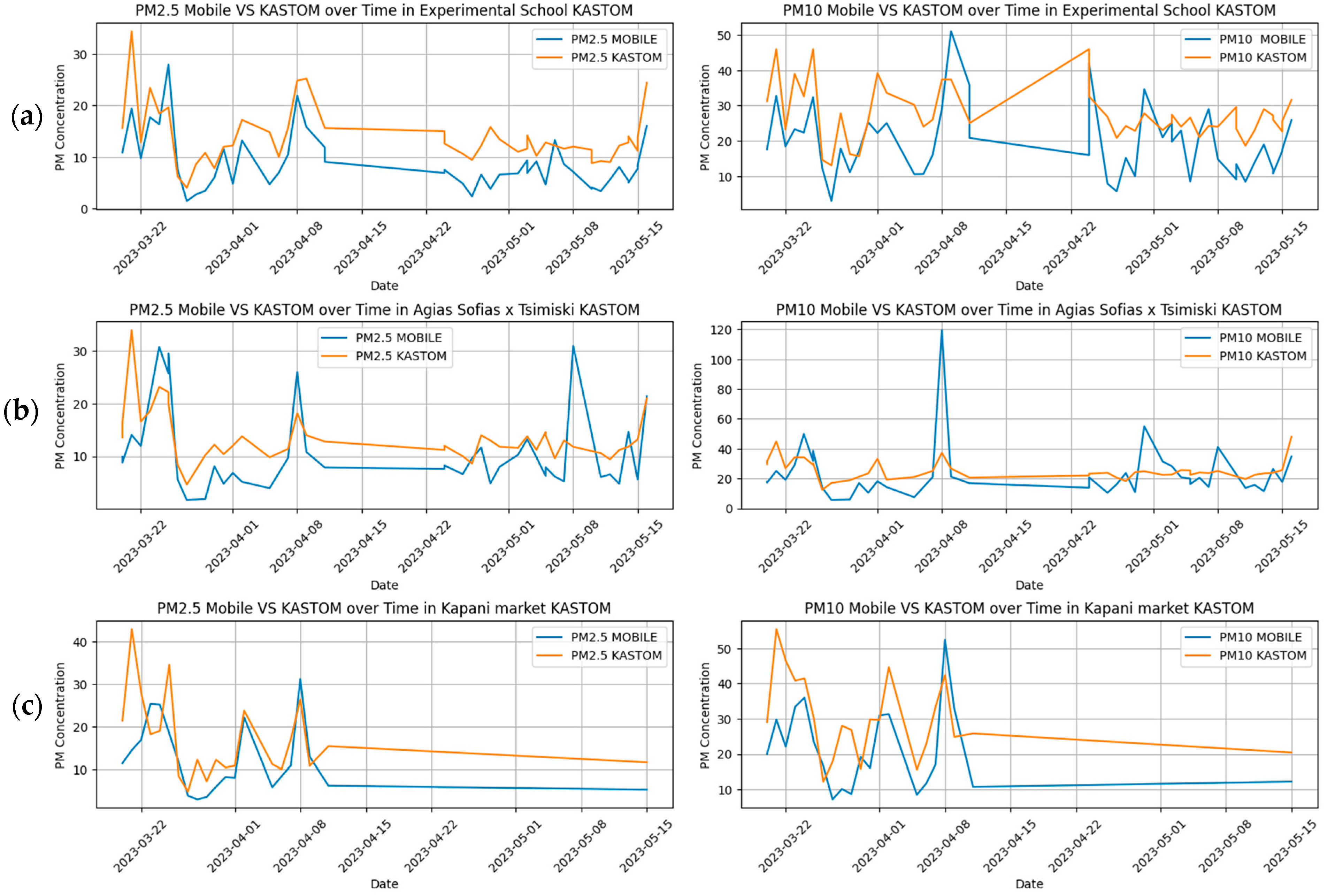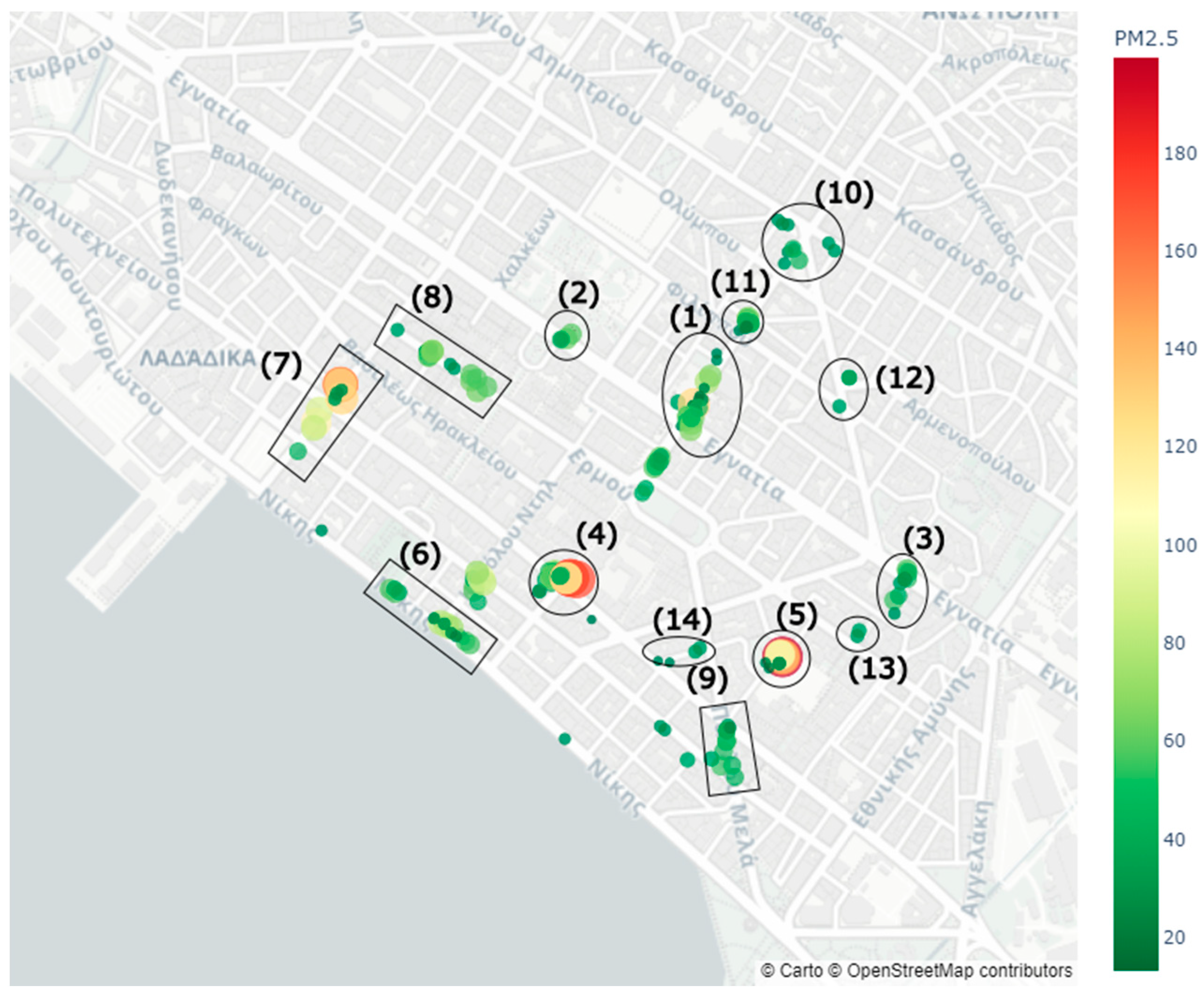Estimation of Particulate Matter Levels in City Center Pedestrian Routes with the Aid of Low-Cost Sensors
Abstract
:1. Introduction
1.1. Background
1.2. Related Work
2. Materials and Methods
2.1. Low-Cost Air Quality Sensor System
2.2. Study Area
2.3. K-Means Clustering
3. Results
3.1. Mobile and Fixed Measurement Comparison
3.2. Statistical Analysis of Measurements
3.3. Data Clustering with K-Means
4. Discussion
- Cluster 0 encapsulates concentration values of PM2.5 and PM10 which are relatively the lowest (mean values of 6.3 μg/m3 and 13.4 μg/m3 respectively) accompanied by lower than the other clusters relative humidity values (59.3%) and the highest mean temperature (18.5 °C). The two measurement periods participate in a relatively balanced way in this cluster, which seems to represent the warmer and dryer measurement days of the experiment.
- Cluster 1 contains PM2.5 and PM10 concentration values higher than the other clusters (mean values of 43.4 μg/m3 and 139.2 μg/m3 respectively). The mean relative humidity of the measurements belonging to this cluster reaches 70.2% while most of the data points belong to the colder period of the study, as reflected in the lowest mean temperature among all clusters (17 °C), and as visualized in Figure 6. Low temperatures are expected to correlate with higher emissions from household heating activities. Moreover, the high relative humidity may lead to an artificially increased concentration measurement by the optical particle counter sensor, due to the hygroscopicity of the PM.
- Cluster 2 contains the second highest concentrations of PM2.5 and PM10 (mean values of 26 μg/m3 and 67.6 μg/m3, respectively). The relative humidity of this cluster is 67.5%, while data points of both measuring periods participate in this cluster.
- Cluster 3 includes concentrations of PM2.5 and PM10 that are higher than those of cluster 0 (mean values of 16.5 μg/m3 and 31.1 μg/m3 respectively) and are accompanied by the highest recorded relative humidity (70.4%). Far greater participation of data points from the colder period may be found here, therefore mechanisms similar to the ones addressed for cluster 1 could also be associated with such values.
5. Conclusions
Author Contributions
Funding
Institutional Review Board Statement
Informed Consent Statement
Data Availability Statement
Conflicts of Interest
Appendix A. Portable Low-Cost Air Quality Sensor System

References
- Fenger, J. Urban air quality. Atmos. Environ. 1999, 33, 4877–4900. [Google Scholar] [CrossRef]
- WHO. WHO Releases Country Estimates on Air Pollution Exposure and Health Impact. 2016. Available online: https://www.who.int/news/item/27-09-2016-who-releases-country-estimates-on-air-pollution-exposure-and-health-impact (accessed on 2 July 2024).
- Wilson, J.G.; Kingham, S.; Pearce, J.; Sturman, A.P. A review of intraurban variations in particulate air pollution: Implications for epidemiological research. Atmos. Environ. 2005, 39, 6444–6462. [Google Scholar] [CrossRef]
- Karagulian, F.; Barbiere, M.; Kotsev, A.; Spinelle, L.; Gerboles, M.; Lagler, F.; Redon, N.; Crunaire, S.; Borowiak, A. Review of the Performance of Low-Cost Sensors for Air Quality Monitoring. Atmosphere 2019, 10, 506. [Google Scholar] [CrossRef]
- Castell, N.; Kobernus, M.; Liu, H.-Y.; Schneider, P.; Lahoz, W.; Berre, A.J.; Noll, J. Mobile technologies and services for environmental monitoring: The Citi-Sense-MOB approach. Urban Clim. 2015, 14, 370–382. [Google Scholar] [CrossRef]
- Moussiopoulos, Ν.; Vlachokostas, C.; Tsilingiridis, G.; Douros, I.; Hourdakis, E.; Naneris, C.; Sidiropoulos, C. Air quality status in Greater Thessaloniki Area and the emission reductions needed for attaining the EU air quality legislation. Sci. Total Environ. 2009, 407, 1268–1285. [Google Scholar] [CrossRef] [PubMed]
- Kinney, P.L.; Gichuru, M.G.; Volavka-Close, N.; Ngo, N.; Ndiba, P.K.; Law, A.; Gachanja, A.; Gaita, S.M.; Chillrud, S.N.; Sclar, E. Traffic impacts on PM2.5 air quality in Nairobi, Kenya. Environ. Sci. Policy 2011, 14, 369–378. [Google Scholar] [CrossRef] [PubMed]
- Kaur, S.; Nieuwenhuijsen, M.J.; Colvile, R.N. Fine particulate matter and carbon monoxide exposure concentrations in urban street transport microenvironments. Atmos. Environ. 2007, 41, 4781–4810. [Google Scholar] [CrossRef]
- Progiou, A.; Liora, N.; Sebos, I.; Chatzimichail, C.; Melas, D. Measures and Policies for Reducing PM Exceedances through the Use of Air Quality Modeling: The Case of Thessaloniki, Greece. Sustainability 2023, 15, 930. [Google Scholar] [CrossRef]
- Tiwari, S.; Srivastava, A.K.; Bisht, D.S.; Parmita, P.; Srivastava, M.K.; Attri, S.D. Diurnal and seasonal variations of black carbon and PM2.5 over New Delhi, India: Influence of meteorology. Atmos. Res. 2013, 125–126, 50–62. [Google Scholar] [CrossRef]
- Russell, H.S.; Kappelt, N.; Fessa, D.; Frederickson, L.B.; Bagkis, E.; Apostolidis, P.; Karatzas, K.; Schmidt, J.A.; Hertel, O.; Johnson, M.S. Particulate air pollution in the Copenhagen metro part 2: Low-cost sensors and micro-environment classification. Environ. Int. 2022, 170, 107645. [Google Scholar] [CrossRef]
- Gozzi, F.; Della Ventura, G.; Marcelli, A. Mobile monitoring of particulate matter: State of art and perspectives. Atmos. Pollut. Res. 2016, 7, 228–234. [Google Scholar] [CrossRef]
- Wang, A.; Paul, S.; deSouza, P.; Machida, Y.; Mora, S.; Duarte, F.; Ratti, C. Key Themes, Trends, and Drivers of Mobile Ambient Air Quality Monitoring: A Systematic Review and Meta-Analysis. Environ. Sci. Technol. 2023, 57, 9427–9444. [Google Scholar] [CrossRef] [PubMed]
- Bagkis, E.; Kassandros, T.; Karatzas, K. Learning calibration functions on the fly: Hybrid batch online stacking ensembles for the calibration of low-cost air quality sensor networks in the presence of concept drift. Atmosphere 2022, 13, 416. [Google Scholar] [CrossRef]
- Zhu, C.; Fu, Z.; Liu, L.; Shi, X.; Li, Y. Health risk assessment of PM2.5 on walking trips. Sci. Rep. 2021, 11, 19249. [Google Scholar] [CrossRef] [PubMed]
- Fameli, K.-M.; Moustris, K.; Spyropoulos, G.; Rodanas, D.-M. Exposure to PM2.5 on Public Transport: Guidance for Field Measurements with Low-Cost Sensors. Atmosphere 2024, 15, 330. [Google Scholar] [CrossRef]
- Aix, M.-L.; Claitte, M.; Bicout, D.J. A Low-Cost Sensors Study Measuring Exposure to Particulate Matter in Mobility Situations. In Proceedings of the 12th International Conference on Sensor Networks SENSORNETS 2023, Lisbon, Portugal, 23–24 February 2023; SCITEPRESS-Science and Technology Publications: Setúbal, Portugal, 2023. [Google Scholar]
- Ramel-Delobel, M.; Peruzzi, C.; Coudon, T.; De Vito, S.; Fattoruso, G.; Praud, D.; Fervers, B.; Salizzoni, P. Exposure to airborne particulate matter during commuting using portable sensors: Effects of transport modes in a French metropolis study case. J. Environ. Manag. 2024, 365, 121400. [Google Scholar] [CrossRef] [PubMed]
- Kassandros, T.; Gavros, A.; Bakousi, K.; Karatzas, K. Citizens in the loop for air quality monitoring in Thessaloniki, Greece. In Advances and New Trends in Environmental Informatics: Digital Twins for Sustainability; Springer: Berlin/Heidelberg, Germany, 2021. [Google Scholar]
- Pope, F.D.; Gatari, M.; Ng’ang’a, D.; Poynter, A.; Blake, R. Airborne particulate matter monitoring in Kenya using calibrated low-cost sensors. Atmos. Chem. Phys. 2018, 18, 15403–15418. [Google Scholar] [CrossRef]
- White, A.J.; Keller, J.P.; Zhao, S.; Carroll, R.; Kaufman, J.D.; Sandler, D.P. Air Pollution, Clustering of Particulate Matter Components, and Breast Cancer in the Sister Study: A U.S.-Wide Cohort. Environ. Health Perspect. 2019, 127, 107002. [Google Scholar] [CrossRef]
- Ahn, H.; Lee, J.; Hong, A. Urban form and air pollution: Clustering patterns of urban form factors related to particulate matter in Seoul, Korea. Sustain. Cities Soc. 2022, 81, 103859. [Google Scholar] [CrossRef]
- Symeonidis, P.; Mitropoulos, P.; Taskaris, S.; Vakkas, T.; Adamopoulou, E.; Karakirios, D.; Salamalikis, V.; Kosmopoulos, G.; Kazantzidis, A. ThermiAir: An innovative air quality monitoring system for airborne particulate matter in Thermi, Greece. In Proceedings of the 13th International Conference on Theory and Practice of Electronic Governance, Athens Greece, 23–25 September 2020; Association for Computing Machinery: Athens, Greece, 2020; pp. 775–778. [Google Scholar]
- Ahmed, M.; Seraj, R.; Islam, S.M.S. The k-means Algorithm: A Comprehensive Survey and Performance Evaluation. Electronics 2020, 9, 1295. [Google Scholar] [CrossRef]
- Bholowalia, P.; Kumar, A. EBK-means: A clustering technique based on elbow method and k-means in WSN. Int. J. Comput. Appl. 2014, 105, 17–24. [Google Scholar] [CrossRef]
- Athanasakis, E.; Kassandros, T.; Karatzas, K. Investigation of traffic and air pollution in Thessaloniki, Greece, under ordinary and COVID-19 pandemic conditions. In Environmental Informatics. New Perspectives in Environmental Information Systems: Transport, Sensors, Recycling. Adjunct Proceedings of the 34th Edition of the EnviroInfo Conference (Nicosia, Cyprus, 23–24 September 2020); Kamilaris, A., Wohlgemuth, V., Karatzas, K., Athanasiadis, I., Eds.; Shaker Verlang: Kassel, Germany, 2020; pp. 84–92. ISBN 978-3-8440-7628-8. [Google Scholar]







| Time | PM2.5 Mean | PM2.5 Std | PM10 Mean | PM10 Std | Count |
|---|---|---|---|---|---|
| 18:15:00 | 6.2 | 2.2 | 13.2 | 3.7 | 78 |
| 18:30:00 | 7.8 | 6.4 | 14.7 | 8.6 | 163 |
| 18:45:00 | 7.6 | 4.3 | 14.6 | 6.2 | 169 |
| 19:00:00 | 9.0 | 9.3 | 22.6 | 23.0 | 968 |
| 19:15:00 | 10.7 | 8.1 | 24.1 | 21.7 | 2037 |
| 19:30:00 | 9.9 | 8.1 | 22.1 | 21.5 | 2754 |
| 19:45:00 | 10.4 | 12.0 | 21.9 | 22.2 | 2798 |
| 20:00:00 | 11.4 | 11.6 | 23.2 | 18.6 | 1846 |
| 20:15:00 | 12.4 | 8.9 | 24.1 | 13.7 | 1053 |
| 20:30:00 | 13.2 | 12.7 | 28.8 | 21.8 | 352 |
| 20:45:00 | 15.6 | 9.7 | 28.5 | 13.1 | 208 |
| 21:00:00 | 21.6 | 6.9 | 35.5 | 11.9 | 153 |
| Day of Week | PM2.5 Mean | PM2.5 Std | PM10 Mean | PM10 Std |
|---|---|---|---|---|
| Monday | 8.0 | 9.3 | 16.8 | 12.9 |
| Tuesday | 11.9 | 7.4 | 25.8 | 17.8 |
| Wednesday | 7.8 | 7.0 | 16.4 | 13.1 |
| Thursday | 10.7 | 8.8 | 21.1 | 14.6 |
| Friday | 11.7 | 9.6 | 23.1 | 14.8 |
| Saturday | 15.1 | 13.4 | 31.8 | 30.8 |
| Sunday | 9.8 | 10.3 | 25.2 | 25.0 |
| PM2.5 | PM10 | TEMP | ||
|---|---|---|---|---|
| Before 9 April 2023 | Mean | 12.5 | 25.1 | 16.8 |
| STD | 10.6 | 23.2 | 2.4 | |
| After 24 April 2023 | Mean | 8.8 | 20.6 | 20.2 |
| STD | 8.9 | 16.7 | 1.9 |
| Cluster | PM10 | PM2.5 | TEMP (°C) | HUM(%) | Count | Count a | Count b |
|---|---|---|---|---|---|---|---|
| 0 | 13.4 | 6.3 | 18.5 | 59.3 | 8120 | 4368 | 3752 |
| 1 | 139.2 | 43.4 | 17.0 | 70.2 | 176 | 34 | 142 |
| 2 | 67.6 | 26.0 | 18.1 | 67.5 | 598 | 238 | 360 |
| 3 | 31.1 | 16.5 | 18.3 | 70.4 | 3689 | 1313 | 2376 |
Disclaimer/Publisher’s Note: The statements, opinions and data contained in all publications are solely those of the individual author(s) and contributor(s) and not of MDPI and/or the editor(s). MDPI and/or the editor(s) disclaim responsibility for any injury to people or property resulting from any ideas, methods, instructions or products referred to in the content. |
© 2024 by the authors. Licensee MDPI, Basel, Switzerland. This article is an open access article distributed under the terms and conditions of the Creative Commons Attribution (CC BY) license (https://creativecommons.org/licenses/by/4.0/).
Share and Cite
Plakotaris, D.D.; Kassandros, T.; Bagkis, E.; Karatzas, K. Estimation of Particulate Matter Levels in City Center Pedestrian Routes with the Aid of Low-Cost Sensors. Atmosphere 2024, 15, 965. https://doi.org/10.3390/atmos15080965
Plakotaris DD, Kassandros T, Bagkis E, Karatzas K. Estimation of Particulate Matter Levels in City Center Pedestrian Routes with the Aid of Low-Cost Sensors. Atmosphere. 2024; 15(8):965. https://doi.org/10.3390/atmos15080965
Chicago/Turabian StylePlakotaris, Dimos Dimitrios, Theodosios Kassandros, Evangelos Bagkis, and Kostas Karatzas. 2024. "Estimation of Particulate Matter Levels in City Center Pedestrian Routes with the Aid of Low-Cost Sensors" Atmosphere 15, no. 8: 965. https://doi.org/10.3390/atmos15080965
APA StylePlakotaris, D. D., Kassandros, T., Bagkis, E., & Karatzas, K. (2024). Estimation of Particulate Matter Levels in City Center Pedestrian Routes with the Aid of Low-Cost Sensors. Atmosphere, 15(8), 965. https://doi.org/10.3390/atmos15080965







